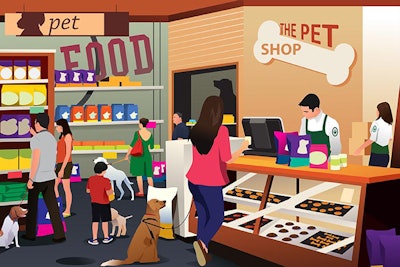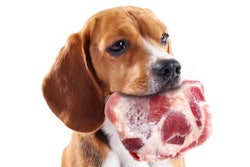
Much of the change and chaos happening in pet food retailing has hit the pet specialty channel in the U.S. the hardest, particularly independent pet stores that find it difficult to compete with large pet store chains, online platforms and mass market outlets that can offer many of the same pet food brands, or similar ones, for lower prices.
Yet, perhaps independents see some bright spots on the horizon. Besides being able to offer some of the newer, growing pet food formats that are trickier for e-commerce players to carry – think raw frozen and refrigerated products – independent pet retailers may also take heart knowing that they have regained some market share previously captured by the two big-box pet store chains, PetSmart and Petco.
Big-box pet chains losing share to independents
Those two chains’ combined share of U.S. pet specialty sales (all products, not just pet food) fell to 47.2 percent in 2018, down from almost 64 percent in 2012, according to a recent report from IBISWorld, Pet Stores in the U.S. History, and reported by Mark Kalaygian, publishing director and editor-in-chief of Pet Business. As he commented, the stores' individual shares – 27.3 percent for PetSmart and 19.9 percent for Petco – are still strong but not as dominant as they once were.
In fact, Pet Business’ own Top 25 Retailers list showed that of the 2,379 new stores opened in the pet specialty channel over the past six years, the two big chains accounted for 34 percent of them, down from 70 percent of new store openings in the previous five-year period (2007-11), Kalaygian said.
He proposed two reasons why “momentum has shifted toward the independents”: the rise of online purveyors of pet products, which typically compete directly with the big chains on price and convenience (and often do it better, some would say); plus the “ongoing evolution of independent retailers” as they’ve learned to leverage their strengths of personal service and in-depth knowledge of pet products, including pet foods.
E-commerce pet food players a threat to all
Indeed, while 10 to 15 years ago, an independent pet retailer might lament the opening of a PetSmart or Petco store in his or her neighborhood as a possible death knell, the two big chains no longer seem the biggest competitive threat to independents.
In its annual State of the Industry report surveying the U.S. pet specialty channel – comprising all pet product and service retailers but with respondents seemingly more likely to be smaller businesses with “typical” gross annual sales of US$250,000 in 2017 – Pet Product News reported that 74 percent of respondents chose Amazon as the competitor posing the most significant threat, followed by Chewy.com at 70 percent. Big-box specialty stores, by comparison, were named by 57 percent. In addition, 62 percent of the retailers responding said one reason for optimism is that their customers prefer small businesses over big-box stores.
All of this points to a key reason why a pet food company like Champion Petfoods might feel safe making a move into Petco stores without fear of alienating all of its longtime independent pet retail partners.
Meanwhile, Amazon and Chewy do loom not only over independents but the big chains, too. According to Packaged Facts’ latest report, Pet Food in the U.S., 14th edition, e-commerce players accounted for 17 percent of U.S. pet food sales in 2018, up from about 11 percent in 2017. In fact, Amazon alone surpassed US$1 billion in pet food sales in 2018, reported Edge by Ascential.
And globally, internet retailing of the pet care category (all products and services) recorded a 25 percent compound annual growth rate (CAGR) from 2013 to 2018, far surpassing that of pet superstores and pet shops, both at less than 5 percent CAGR. That’s according to data from Euromonitor International.
Mass market threatens, but exclusive pet food brands help
Besides online retailers, mass market poses another significant threat as more natural and premium pet food brands expand to that channel. In 2018, mass market chains like Walmart and Target earned a 20 percent share of U.S. pet food sales, said Packaged Facts; and in the Pet Product News survey, 43 percent of pet specialty retailers identified mass market big-box stores as a significant threat, followed by Walmart specifically at 36 percent.
Thus, independent pet retailers enjoyed only a 9 percent share of U.S. pet food sales in 2017, according to Packaged Facts, and overall pet food sales growth was nearly flat, per GfK data. It’s not as though their outlook is all rosy.
Still, independent pet stores have definite strengths – including their exclusive agreements with some pet food brands, in addition to service and expertise. In 2017, GfK reported that brands exclusive to what it called the neighborhood pet (NHP) channel saw sales growth of 75 percent over the previous five years, compared to a 1.7 percent decline for brands in pet specialty overall. The NHP-exclusive brands had a 17.8 percent share of pet specialty’s overall U.S.$8 billion pet food sales, up 6.1 points since 2011, compared to overall pet specialty brands’ decrease of 1.8 points.

















